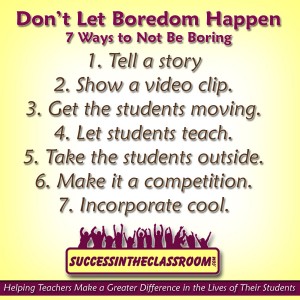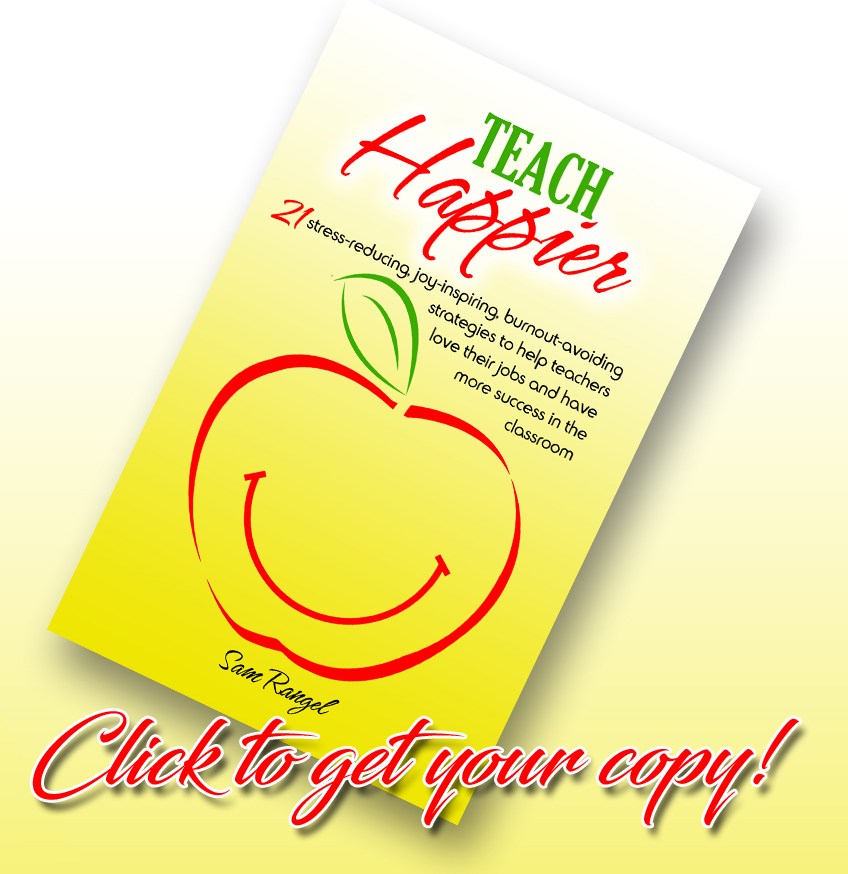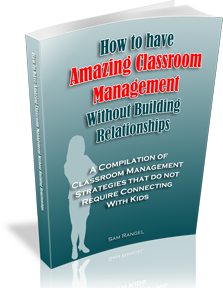“Don’t let boredom happen.”
This was what Amanda Dykes shared with me when she was a guest on the Amazing Teacher Podcast.
Four words that are so critical to a teacher’s success in the classroom, especially if you teach middle school kids like I did.
When kids are bored, they find other things to entertain themselves with.
They start talking with their friends in the next row.
They shoot paper balls into the trash can.
They start counting the number of tiles in the ceiling, or they suddenly have the urge to use the restroom.
They stop listening to you, and start listening to whatever else is in their mind.
Boring is bad.
Boring is why some students get in trouble.
Boring is why some students don’t learn.
Amanda’s words are so true.
So if you find yourself noticing that students are beginning to check out while you’re teaching, here are 7 ways to keep boredom from happening
1. Tell a story. – Kids like stories. Everybody loves a good story. I loved telling stories. I still love telling stories. It’s always good to have a cute or funny story in your back pocket for those times when you need to break things up a little. It should connect with what you’re teaching, but not always. Sometimes, you just need to take a break from the lesson to stop boredom from happening. If don’t have a story, make one up. Create an example that connects with what you’re teaching. For example, I was teaching about England and the American Colonies and how they were angry at each other. I started with, “I knew this guy, and he had a girlfriend…” I compared the relationship between a boy and a girl to the relationship between England and the American Colonies. Make sure you keep the story short. Even the best stories can get boring after a while.
2. Show a video clip. – It is so easy now to find an interesting video clip to show about your subject. Just go to YouTube, and you’ll find quick 5-10 minute videos that you can use to reinforce what you’re teaching. I wish I had YouTube when I first started teaching. I remember using movie projectors with the reels of film. Anybody remember using those? Make sure you preview the YouTube video first.
3. Get the students moving. – It’s tough to sit in a chair for 40 minutes. When you begin to feel boredom invading your classroom environment, get the students moving. Have them find three friends across the room and write down their favorite color or food or opinion. It has to somehow relate to the lesson, but having them move around the room keeps them engaged. Tip: Make sure you give them specific time limits. Say, “Alright. You have 3 minutes to find two different people in the room and get their answer to the following question: (Insert question here.) Ready? Go. At the three minute mark, say, “10 seconds to get back to your chair 9…8…7….” This short 3-5 minuted break will keep boredom from settling in. Be creative. It’s fun.
4. Let students teach. – Sometimes kids are just tired of hearing your voice. It’s late in the day, and you’re reviewing for a test, and boredom’s fog is creeping into your classroom. Ask, “Who knows what I’m talking about?” Hands will go up. “Alright Johnny. What should the class remember most for the test tomorrow?” Students will perk up to hear one of their own teach the class. Some will even start to interrupt and add their own two cents. You just have to sit back and listen.
5. Take students outside. – I used to love taking my kids outside. Sometimes the lesson will lend itself to leaving the classroom and teaching outside on the lunch benches or walking around the school. You can’t do it every day, or else the novelty wears off, but every now and then, taking the kids out of the confines of the classroom is a great way to keep boredom away.
6. Make it a competition. – Boys against girls – this side of the room against the other side of the room – random team selection. When you include some kind of competition into your lesson, boredom has no chance. I used to have the kids’ names on index cards, and after shuffling, I would call the names of the kids one at a time and tell them which team they were on. “Johnny – this side (pointing to the left side of the room) Mary – this side (pointing to the other side of the room).” Then, I would play the Rangel Game. You can create your own game to review for the test or to just reinforce a concept. Again, you can’t do it every day, but when you make your lesson a competition it makes boredom a non-issue.
7. Incorporate cool. – What is cool? Who is cool? As I write this, Taylor Swift is cool. Taylor Swift is the topic of conversation everywhere. I like Taylor. Remember when the Backstreet Boys were cool? Boredom hates Cool. Boredom will not be anywhere near Cool. So when you see Boredom sauntering into your classroom, just say, “I was talking with Taylor Swift yesterday…” Or start reciting some of Taylor Swift’s lyrics as part of your lesson. Keep an eye out for what’s cool. Ask your students about what’s in at the moment. Most likely, if you’re like me, you’ll be surprised. You’ll say, “What about Justin Beiber or One Direction or Harry Potter?” They’ll laugh at you, and you’ll feel old.
“Don’t let boredom happen.”
Great advice, Amanda.
If you have more ideas on how to keep boredom from happening, I would love to hear them. Please share.
Find Amanda Dykes at Upside Down Education and on Twitter at @AmandaCDykes.
Be sure to follow SITC on Twitter, Facebook, and Tumblr to be notified when I post more ways to make a difference in the lives of your students.
Until next time,
Here’s to your Success in the Classroom!
Thanks,
Sam





Neat ideas! 🙂